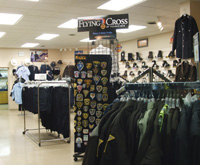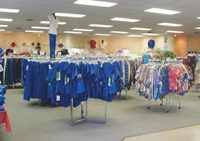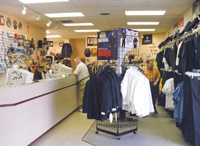|
By Susan Derby Crossing the mid-century mark was something The Uniform House may never have done if not for the fresh leadership of first David Hoffman in the 1970s and then Bob Tavel in the 1990s. What started as a small side business of a bustling industrial cleaners and uniform rental store grew slowly and had many stumbling blocks in its first years. Manuel Manny Leve owned the cleaners and hired members of his family to fill positions within his business. When Nate Prince, Leves brother-in-law, closed his neighborhood grocery store, he was then available to manage a new portion of the uniform rental business custom embroidery and uniform sales. The Uniform House was born in the early 1950s specializing in embroidery work for little league uniforms and custom bowling shirts but also serving as a retail source for coveralls, waitress apparel and industrial uniforms. Leve supplied the original investment of $1,500 and put Prince in charge of the Indianapolis store. Nate Prince really focused on the little league and bowling shirts as the main business of The Uniform House, and it was like that for many years until 1968, Hoffman says. It had limited success, sometimes making just enough to post a profit annually, but it provided jobs and helped spread the family business to a new market of customers. Prince brought Hoffman into the company in 1968. At that time, they decided to broaden the types of uniforms sold to include white and blue goods, and to slowly bring the focus away from the custom embroidery of little league and bowling shirts. Hoffman says the company did about $70,000 in sales for the year before he came aboard. I started on a Monday morning, and within the first hour on the job, I made my first sale for $2,000, he says. My agreement with them was that if after my first year there was a profit, I could buy Nate out, and if not they could close it and I would just find another job. By the end of the year, I had built it up to about $400,000 in sales in 1970. Since then, the business has built up every year. Hoffman served as manager and outside salesman though 1995. He did buy out Princes share of the ownership and remains involved in the operation, though he is semi-retired and spends his winters in Florida. Hoffman is one of a trio of owners. The other two are majority-owner and Leves grandson Bob Tavel, and a silent partner. It was when Tavel joined The Uniform House in 1993 that efficiency and streamlining became key to its most recent transformation. In that year, Tavel graduated with an MBA in finance from Indiana University and was considering whether to return to Hewlett Packard as a computer engineer or to join his grandfathers company. The idea of being in a more managerial position appealed to him, though he didnt have any background in the apparel or retail industries. Hoffman welcomed Tavel into the company, glad to see that the little boy he had known at 2 years old had grown up to be such a strong businessman. Aviva, Bobs wife and a manager at The Uniform House, says, When Bob first started, Dave asked him to prepare a letter and pointed him to an old typewriter, and Bob went into a sweat because he was accustomed to working on computer. Bobs first priority became bringing computers to The Uniform House to speed up sales, manage inventory, track customer information and ensure accurate order filling. His computer engineering background helped keep costs down because he could manage most of the improvements himself. Aviva says, Now people who are not really accustomed to being on computers, like our seamstresses and embroiderers, are helping keep track of things too so that were all able to see how things are moving along the order process. Everything has been computerized, and we have worked really hard the past few years to get our warehouse up to speed. We are trying to make sure that we are working efficiently. That has moved us into a new way of looking at service and how effective we are at serving our customers. Bob says the computerization was important because the uniform industry is so specific and custom. While uniforms themselves dont change fashion quickly, there are stripes, emblems, buttons, seams and sizes that need to be exactly right. Bob calls the detail-oriented industry a curse and an opportunity at the same time that its difficult but, if done well, profitable. One of the other big changes in the past few years has been a hard look at everything in the 10,000-square-foot warehouse. By removing the items that werent active products and putting the oldest items on clearance, enough space was opened in the stockroom to move the outside sales and administrative staff there. That in turn made 600 square feet available for the showroom. Our sales staff was having to run back and forth to get things from the other side of the warehouse. So we rearranged everything so the stock is as close to the sales area as possible, which saves our staff time and in turn saves our customers time. The time they are running back and forth has been diminished by as much as two-thirds, says Aviva. It has proven to be worthwhile because we can stock our higher-selling items on the sales floor and we dont even have to go in the back to get the customers what they want. Plus there are impulse-buying items that we couldnt have on the floor because there just wasnt enough space. When we opened it up and were still not even showing a tenth of our inventory but our customers said, Wow, we didnt realize you had all of this. We have always sold gloves, but now they are a top item because people can see them all hanging there. Its like having bubble gum at the grocery checkout. The Uniform Houses top-selling item is scrubs. The main retail store, which carries white and blue goods, is conveniently located across the street from the largest hospital in Indiana. A second store, in Carmel, Ind., specializes in mainly white goods and high-end accessories. The two locations are within driving distance, making it possible for the staff to cross-train at both locations and fill in as needed. Additionally, The Uniform House operates two scrub-mobiles that travel almost every day to different hospitals, nursing homes, care facilities and doctors offices. Each has two dressing rooms and is staffed by one person. Our biggest change was when scrubs came along. When I came into the industry, there was no such thing as a pants suit. Nurses wore white uniforms, usually long sleeved and usually a dress or skirt, Hoffman says. A call from one of his customers revealed that many of the nurses didnt like how a dress left them exposed when they bent over to adjust a patient or retrieve something dropped. He called the manufacturer to request a sample, smock-length top in the same style as the dress and pants of the same material. The nurses loved the new uniform samples, and the pants suit uniform began to spread. Hoffman says, People became more up-to-date in their uniforms when pants suits caught on, and now they are scrubs. Also the word uniform no longer exists like it used to. If you take a white dress shirt or a golf shirt and put a logo on it, it becomes a uniform. Uniforms can be worn by everyone under the sun. Aviva applauds the diversity of The Uniform House, both in its customer base and in its method of doing business. When Indiana faced a budget crunch, cutting back on police and public service employees, the business could fall back on its white goods sales. While the scrub-mobiles were new and ironing out the wrinkles in their operation, the two regular storefronts were able to keep the bottom line stable. The Uniform House boasts 25 to 30 full-time employees, including five seamstresses, two embroiderers, three warehouse personnel, three outside salespeople and two employees at the Carmel location. As Bob says, Running a successful business takes many different skills on a wide range of topics, from human resources to technology to finance to sales. Im really good at some of those but certainly not all of them. I think the hardest issue is trying to find other qualified people to fill in the voids where Im weakest and to hold it all together in unison while pursuing the same goal. Hoffman, Bob and Aviva all agree that service comes first when it comes to customer retention. Hoffman is still in contact with one of the first clients he brought to The Uniform House. Aviva explains the simple test she puts potential hires through seeing if they pick up a casually dropped item. If the people dont care enough to pick up a pen or piece of paper for someone else, they probably wont give the level of service for which The Uniform House has become known. And Bob knows that a more efficient process means more essential face time with the customers. The Uniform House
|
When we opened it up and were still not even showing a tenth of our inventory but our customers said, Wow, we didnt realize you had all of this. We have always sold gloves, but now they are a top item because people can see them all hanging there. Its like having bubble gum at the grocery checkout. Aviva Tavel
|
| Above story first appeared in MADE TO MEASURE Magazine, Fall & Winter 2007 issue. All rights reserved. Photos appear by special permission. | |
| Halper Publishing Company 633 Skokie Blvd, #490 Northbrook, IL 60062 (877) 415-3300 Fax (224) 406-8850 [email protected] |
|













